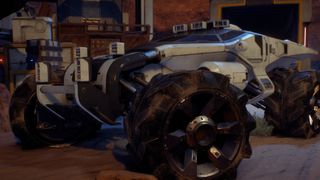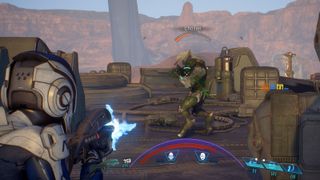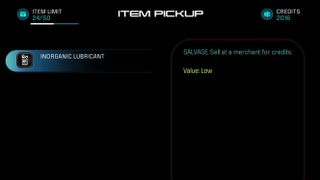Nine things I wish I knew before I started playing Mass Effect: Andromeda
Get the most out of that first ten hours.

I've poured a… disproportionate amount of the last week into Mass Effect: Andromeda, far beyond the ten hours that we're allowed to talk about ahead of our full review on Monday. Even so, there are thousands of people making a start in the game today as part of EA's Access (read: demo) system. Here are a few things I'd like to have known before I began that journey myself.

Get ready for a slow start
As noted in our first impressions piece yesterday—and many places besides— Mass Effect: Andromeda starts slow and exposition-heavy. In that regard, it's a lot like, well, every other BioWare game. Dragon Age: Inquisition is the most recent example of this phenomenon, but it's something that BioWare has struggled it throughout its history. The first Mass Effect—which Andromeda follows after in many ways—hit many of the same early roadblocks. Just like you once spent ages wandering the Citadel doing fetch quests for aliens, you should expect a similar momentum-arresting chunk of space station-based walk-and-talk in Andromeda.
Appropriately-calibrated expectations help a lot, here. Andromeda does hit its stride, and it gets there sooner and with much less fuss than Inquisition and arguably even the first Mass Effect. It's slower than Mass Effect 2, mind, but most BioWare games are. If you've played this type of game before, you know the drill: push through the exposition and the clunky early dialogue and there are rewards beyond. Rest assured that your first male companion isn't representative of the interesting cast you'll meet very soon, and don't fret too much about min-maxing every area right at the start. You're going to spend a lot of time in this world.

Make sure to actually, y'know, explore
Andromeda is a game about exploration, ultimately, which goes some way to explaining why BioWare has shifted away from the corridor shooter formula that powered ME2 and ME3. Instead, Andromeda's mission areas branch out like RPG dungeons. It's well worth taking the time to push back the fog of war as you work your way through each one, and periodically check your scanner to look for points of interest. There are minor plot points to be uncovered if you take the time, and a few of these will affect later conversations. You're not going to miss out on anything major if you stick to the critical path, but putting in a bit of extra legwork is rewarded.
...but don't get bogged down
Here's the flipside. If you religiously attempt to uncover every secret, read every datapad and do every sub-quest before moving on, it's easy to lose momentum. You will get multiple opportunities to return to most of Andromeda's open-world zones, so conserve your min-maxing for one-shot mission areas. You've got a spaceship: I strongly encourage you to use it to chase down the critical path whenever planet-roaming starts to prove a chore.

You don't have to spend your entire life in the galaxy map
For my money, this is the best galaxy map in the series. It has some of the sense of scale of the first game without the irritating pixel-hunting for secrets, and it lets you scan each planet without devolving into a Mass Effect 2-style timesink. Also, you're in no danger of having to steer a tiny Normandy away from the Reaper cops.
The arguable flaw this time around is the extended space travel animation that plays as you travel from point to point. I actually quite like this: it's atmospheric and provides a sense of scale and spectacle, which is great for anybody who liked to wallow happily in the galaxy maps of old. If all you want to do is shake down each star system for loot, however, then I can see why it might frustrate.
The good news: you don't need to shake down each star system for loot. Systems with active objectives are highlighted with an animated ring in the cluster view. If all you want to do is clear out your quest journal, you only need to worry about those.
Comic deals, prizes and latest news
Sign up to get the best content of the week, and great gaming deals, as picked by the editors.

Watched out for timed challenges
There is at least one of these in the game's opening hours, so watch out: occasionally, Andromeda will give you a limited window to get from A to B. It's easy to miss the timer that appears in the top right corner of the screen when this happens. If a quest sounds like it might carry a degree of urgency, its worth watching out to make sure you're not on the clock if you want the best outcome.

Chain jumps and evades
Ryder has access to a boosted jump as well as a horizontal dash, bound to the middle mouse button, intended to get you out of rough spots in combat. These can be chained together despite the fact that double-jumping or double-evading is otherwise impossible. You can cover quite a lot of distance quite quickly by evading at the apex of a jump. This is useful for repositioning during combat, particularly if you're playing a class that specialises in long-range engagement. It has non-combat applications too, however: comboing these two moves to cross large gaps and mitigate fall damage helps you reach inaccessible areas more quickly, and in some cases bypass otherwise-lengthy descents.

Use consumables—and combos!
Ryder can equip a limited pool of consumables, accessed via the Tab key—the weapon and ability wheel. Special ammo types make tough encounters easier, and also operate as combo openers. Other combo openers—which include biotic powers like Pull—are indicated on your action bar by a little white circle icon. Combo detonators like Push have a little explosion icon. Pay attention to this: it's how you do a lot of damage very quickly. In fact, Andromeda places more emphasis on this kind of RPG-style combo play than it does on gun combat. You'll also notice that your companions will shout specific things before using their own combo-initiating powers. If you hear Peebee yell "gravity going away in three, two, one…", get ready with a detonator.
Pay attention to augs and modifications
When you first start tinkering in the research and crafting system, it's tempting to gravitate towards guns and armour. In my experience, however, augmentations and mods are more interesting. While each gun has its own statline and behaviour, crafting one with the right modification can substantially change how it operates—adding new modes of fire, damage types, and so on. The same is true for armour. Setting aside some research points for mods unlocks drop attacks with elemental damage, bonuses while hovering, and so on. The cool thing about this system is that it allows you to focus on wearing the armour that you like the look of while benefiting from bonuses tailored to your chosen class.

And remember: scavenge as much lube as you can carry
It's a big, sexy galaxy out there, and these mysterious ancient aliens wouldn't have left so much lube lying around if they didn't intend you to use it.*
*Or sell it to vendors, which is sadly all it's actually for. Never mind.
Joining in 2011, Chris made his start with PC Gamer turning beautiful trees into magazines, first as a writer and later as deputy editor. Once PCG's reluctant MMO champion , his discovery of Dota 2 in 2012 led him to much darker, stranger places. In 2015, Chris became the editor of PC Gamer Pro, overseeing our online coverage of competitive gaming and esports. He left in 2017, and can be now found making games and recording the Crate & Crowbar podcast.
Most Popular




